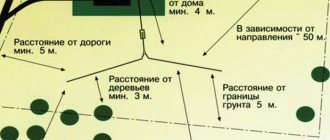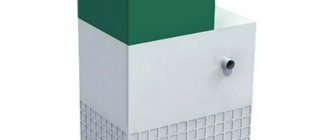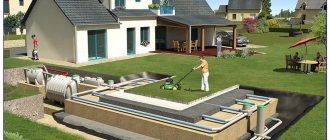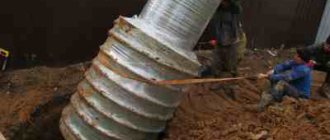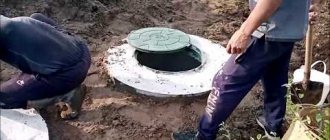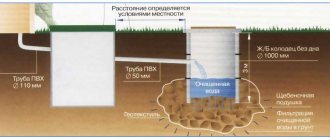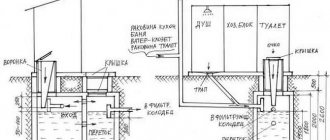When you need to organize an autonomous sewer system, the first thing you need to decide on is a septic tank. One of the best options is equipment produced by Terra.
The model range of this manufacturer allows you to choose the best option, taking into account the hydrogeological features of the land plot. Also, remember that the installation must match the plumbing fixtures of the home.
Septic tank Terra
About the manufacturer
The Russian company is engaged in the design, production and installation of autonomous sewer systems. The products are made from polymer materials. Wastewater treatment systems are available in various capacities. All company products are certified and meet the highest quality standards.
The products of Terra Los LLC are characterized by:
- high level of environmental safety;
- durability (it is not subject to corrosion and can work effectively for more than 50 years);
- resistance to groundwater and low temperatures;
- special strength (made of multilayer polyethylene, the wall thickness of the products is 25-50 mm, the tanks have a minimum number of welds, the outer surface of the tanks is reinforced).
Pros and cons of domestically produced septic tanks
The design features explain the advantages of the installation; they are expressed in effective wastewater treatment, long-term operation, absence of unpleasant odors, resistance to soil pressure and the ability to install a cylindrical structure in places where the groundwater level is high.
Pumping out solid sediment from the bottom of the chamber
The disadvantages of Terra are its dependence on electricity, and not every person can afford to operate such a septic tank. However, it is worth noting that even if there is a power outage, the system can operate for another 5 hours. If you install a septic tank incorrectly or do not maintain it in a timely manner, other, not entirely pleasant, shortcomings may appear. Maintenance of Terra consists of periodically pumping out solid sediment from the bottom of chamber No. 1 (approximately once every 1-2 years). Filters need to be cleaned at the same frequency.
Scope of use
Septic tanks are a modern alternative to cesspools. They are designed for drainage, collection and treatment of domestic wastewater in private households.
The units consist of several sealed chambers connected to each other. The number of chambers directly affects the quality of water purification.
Note! Terra septic tanks, according to the technical specifications stated by the manufacturer, purify water by 98%, regardless of modification.
Conventional layout and installation diagram
general description
The manufacturer offers two versions of Terra brand septic tanks, they differ little in appearance, but their operating principles are different, since one option is energy independent, and the second requires an electrical connection.
Frame
The septic tank has a durable plastic body. The material used to make the tank is multilayer polyethylene. The main thickness of the tank is 2.5 cm; on the stiffeners the thickness is doubled.
Inside, the station is divided by partitions into five tanks, each of which undergoes a specific cleaning cycle. The tanks are connected in series by overflow devices (in non-volatile installations) or airlift tubes (in models with a compressor compartment).
Cleaning principle
When wastewater enters the station, it goes through several stages of purification. Scheme of operation of a volatile installation:
- Through the sewer pipeline, the wastewater flows by gravity into the receiving compartment, where the settling process is carried out. A sediment of inclusions that are heavier than water forms at the bottom of the chamber;
- freeing from most of the large debris, the water enters the second compartment, where the aeration process is carried out, during which the water is purified from organic impurities;
- then the water enters the third compartment, where it again undergoes a settling process;
- in the fourth compartment additional cleaning occurs;
- practically clean water enters the fifth compartment, from where it is discharged by gravity or forcibly using a drainage pump.
Advice! The non-volatile version of the Terra septic tank works on the principle of conventional settling tanks. But thanks to the presence of several biological filters, the quality of cleaning in the Terra septic tank is significantly higher than in a conventional septic tank.
Principle of operation
The wastewater treatment process proceeds as follows:
- Water from the house's sewerage system flows by gravity into the first container. It separates into heavy sediment and a light component. Sludge, consisting of feces and other waste that ends up in the sewer, settles to the bottom of the chamber, and the settled water flows into the second chamber through the overflow pipe.
- Aeration and oxidation occur in the intermediate chambers. Also at this stage, the process of cleansing and clarification occurs due to the work of bacteria.
- The last chamber receives water suitable for reuse, for example, for irrigation. It is pumped out of the tank forcibly using a pump.
Terra septic tank installation
The VOC body is made of low-density polyethylene. The thickness of its walls is 25 mm; the structure is strengthened by 50 mm stiffening ribs. They are located along the outer wall of the housing in 15 cm increments. This design provides high resistance to loads and soil pressure. The septic tank has a cylindrical shape with a neck at the top of the structure. The vertical design requires a minimum area for installation of the structure.
Attention. The plastic body of the unit has no welds, which significantly increases its reliability.
The interior of the station is divided into 5 chambers, providing step-by-step cleaning of incoming sewage waste. Communication between them occurs using a system of overflows and airlifts. For a high degree of purification of domestic wastewater, mechanical and aeration processes are used. To ensure that aerobic bacteria receive a sufficient amount of oxygen, a compressor is installed inside the housing. A pump is installed in the last chamber to remove clean water.
Internal structure of the Terra septic tank
Information. The Hiblow HP diaphragm compressor has low energy consumption and is recommended for use in sewage installations with biological filtration.
The lineup
Terra septic tanks are available in two versions:
- Practitioner (vertical 4 chamber). They have the prefix PR in their name.
- Horizon (horizontal 3 chamber).
Each of the modifications is represented by units of varying power. The thickness of the reinforced walls, depending on the model, is 12-16 – 25-50 mm.
Terra PR (Practitioner)
It is a vertically located cylindrical container. On the outer surface there are stiffening ribs that provide effective resistance to compression.
Tanks are produced with a volume of 1.2 to 5 cubic meters, designed to serve from 3 to 20 people.
The vertical arrangement allows you to install a septic tank in a small area. However, there is a need to dig a deep pit.
Terra Horizon
They are horizontally located cylindrical containers with one or two necks. The outer surface is reinforced with stiffening ribs.
The containers are available in volumes from 2 to 5 cubic meters. Capable of serving from 3 to 10 people.
The horizontal position of the septic tank allows installation without digging a pit that is too deep. However, placing a horizontal container requires additional space on the site.
External view of the Terra Horizon installation
Installation of the Terra treatment plant
The installation of an autonomous sewage system "Terra" is carried out by analogy with the installations "Deka", "Rostok", "Topol", etc.
Advantages of Astra septic tanks and review of models
First of all, you should decide on the choice of location for the Terra septic tank. It must be removed from the house and all buildings at a distance of 5 meters or more. If there is a well or borehole on the site, then you need to remove the septic tank from them at a distance of 20 meters. In this case, it is desirable that the treatment system be located in the lower part of the site’s topography.
Now the pit is being prepared. Its parameters must exceed the dimensions of the tank by 40 cm on each side. The bottom of the pit is covered with sand 30 cm thick and compacted well. The septic tank is installed vertically and with perfect evenness.
Important: it is necessary to ensure that the hatch cover of the container rises 1.5 meters above ground level. This will prevent melt or rainwater from entering the reservoir from the surface of the site.
To prevent the septic tank from being washed away by groundwater or giving way to soil during the heaving seasons, it is advisable to backfill the tank with a cement-sand mixture at a rate of 1:3. You need to start from the bottom and step by step, first filling the septic tank with 20-30 cm of water. After this, pour the sprinkle and tamp it well. Then water is poured again and a layer of sprinkling is laid again. This installation technology will avoid pressure drops on the walls of the septic tank and its subsequent deformation.
The top of the tank is covered with thermal insulation material and covered with soil, just like the Deka septic tank and other models of autonomous sewage systems. All that remains is to connect the sewer pipe, mounted on a slope, and electricity.
Autonomous sewage systems
Terra vertical and horizontal septic tanks are the main element of autonomous installations for collecting and treating wastewater. In addition to the tank itself, autonomous sewer stations are equipped with;
- compressor (installs HIBLOW-XP, HP (Japan) or THOMAS units);
- control system;
- stabilizer and stationary sludge pumping device;
- ventilation device (located in the septic tank on the hatch);
- pipe aerators "Matala";
- three-layer reinforced air supply hoses;
- fittings;
- couplings;
- distribution comb.
Internal device
At the customer's request, Terra stations are additionally equipped with an alarm system and a pump for forced release.
Note! If the power supply is interrupted, the Terra station can operate in wastewater reception mode for up to 5 hours. Once the voltage supply is restored, the unit returns to normal operation.
Terra Los LLC produces autonomous sewer systems of various capacities.
The lowest-power installation is the Terra 3 septic tank. The station has the smallest dimensions of 1.2x2 m. The weight of the Terra 3 septic tank is 150 kg, the productivity does not exceed 300 liters per day. The Terra 3 septic tank can withstand a burst discharge of up to 150 liters.
The most popular, according to reviews from companies involved in installing sewer systems, are the Terra 5 PR and Terra 8 PR septic tanks. Both of these stations are equipped with tanks with a diameter of 1300 mm, but with different heights and weights of 2.1 m and 270 kg (Terra 5 PR septic tank) and 2.3 m and 320 kg (Terra 8 PR).
The technical characteristics of these and other stations can be viewed in the table.
| Terra autonomous system model | Installation dimensions, m | Power consumption, W | Weight, kg | Volume, cubic meters/day. | Volley. reset, l |
| 3 | 1.2x2 | 50 | 180 | 0.6 | 150 |
| 3 PR | 1.2x2 | 50 | 180 | 0.6 | 150 |
| 3 Long | 1.2x2.5 | 50 | 220 | 0.6 | 150 |
| 4 | 1.25x2.1 | 60 | 240 | 0.8 | 200 |
| 4 PR | 1.25x2.1 | 60 | 240 | 0.8 | 200 |
| 4 Long | 1.25x2.6 | 60 | 290 | 0.8 | 200 |
| 5 | 1.3x2.1 | 60 | 270 | 1.2 | 250 |
| 5 PR | 1.3x2.1 | 60 | 270 | 1.2 | 250 |
| 5 Long | 1.3x2.6 | 60 | 310 | 1.2 | 250 |
| 8 | 1.3x2.4 | 80 | 320 | 1.6 | 350 |
| 8 PR | 1.3x2.4 | 80 | 320 | 1.6 | 350 |
| 8 Long | 1.3x2.9 | 80 | 350 | 1.6 | 350 |
| 10 | 1.35x2.5 | 100 | 380 | 2 | 500 |
| 10 PR | 1.35x2.5 | 100 | 380 | 2 | 500 |
| 10 Long | 1.35x2.9 | 100 | 420 | 2 | 500 |
| 20 | 1.75x2.5 | 150 | 540 | 4 | 800 |
| 20 PR | 1.75x2.5 | 150 | 540 | 4 | 800 |
| 20 Long | 1.75x3 | 150 | 610 | 4 | 800 |
Note! Models with the Long prefix have large dimensions and total weight due to the elongated tank neck. This is their only difference from the basic modifications with a vertical container arrangement.
Model specifications and prices
There are two types of Terra septic tanks - volatile and non-volatile.
Outwardly, they are similar to each other, but the operating principle and technical characteristics are somewhat different.
For example, Terra autonomous sewage system is available in 4 types.
The minimum processing volume is 0.6 m3, and the maximum is 2 m3.
The volume of salvo discharge changes accordingly; you can choose the Terra 3 model, which discharges 150 liters at a time, or Terra 5 - 250 liters, Terra 8 - 350 liters, Terra 10 - 550 liters.
Septic tanks that operate using electricity are much more expensive than energy-independent installations.
The minimum cost is 71 thousand rubles, and the maximum is 119 thousand.
Volatile septic tanks Terra
Non-volatile septic tanks Terra have 4 chambers inside, their processing volume is 1.2 - 3.0 m3, and their productivity is 500-1500 l/day.
The price of equipment is determined by the volume of capacity and other factors.
For example, the model Practice 3 costs 39 thousand rubles, and the most voluminous installation, Practice 10, is estimated at 72 thousand rubles.
How to calculate the required volume of a septic tank
You can calculate the volume of a septic tank required for a particular home yourself. The calculation is based on the number of people permanently residing in the house. According to SNIP standards, approximately 0.2 cubic meters are consumed per person. water per day. The volume of the septic tank must be at least three daily norms for each person.
For example, if 4 people permanently live in a house, then every day they spend 4 x 0.2 = 0.8 cubic meters. water.
Three times the daily volume will be: 0.8 x 3 = 2.4 cubic meters.
Station maintenance
In accordance with the instructions, during the operation of the Terra, the following work must be performed regularly:
- If a constant outlet of purified process water from the station is not organized, then as it is filled, approximately once every 4 months, the liquid should be pumped out with a pump.
- After 1-2 years, using the stationary pumping included in the package, sludge is removed from the installation.
- At the same time, the filters are washed with water from a hose.
If the station is installed, operated and maintained in accordance with the instructions, it will ensure a comfortable life in your home.
Installation features
Installation of the cleaning station is carried out in the following sequence:
- A convenient location for the septic tank and sufficient area on the site is determined.
- A pit is being dug, slightly larger in volume than the treatment plant. The depth of the pit should be such that after laying the backfill and installing the septic tank, its cover rises 150 mm above the ground level. This will eliminate the possibility of melt and rainwater getting inside the installation.
- Trenches are being dug for pipes.
- A 200 mm thick sand backfill is laid at the bottom of the pit. If the pit is dug in an area with high groundwater, the backfill is made from a mixture of sand, cement and crushed stone.
- The unit is lowered deep into the pit.
- The space between the tank and the walls of the pit is filled with cement-sand mortar. Simultaneously with filling, the container is filled with clean water. This is done to uniformly distribute pressure from the outside and inside onto the walls of the installation.
- A sewer line is being installed.
- The power supply is connected.
Installation of a Terra Horizon septic tank in a trench
User manual
Terra septic tanks are fully equipped, so there is no need to look for additional parts. It is better to entrust installation to specialists, since proper installation of the system is a guarantee of its long-term operation. Firstly, the design of the installation is quite heavy (about 150 kg), so installation requires people who will do all the work without using special equipment. Secondly, correct installation of the system guarantees its long-lasting operation.
Due to its characteristics, the installation can operate effectively for 50 years. But in order for it to work without failures, it is necessary to ensure proper maintenance of the system:
- visually inspect all cameras of the system once every six months;
- regularly wash the coarse filters;
- silt settles at the bottom of the first chamber, which must be removed periodically. When using biological products for septic tanks, cleaning can be done only once every 5-8 years.
Servicing should be carried out 2 times a year.
Reviews
People who bought Terra septic tanks leave mostly positive reviews about the installations.
They also note that the seller provides quality certificates for the devices.
Reviews from summer residents who have been using an autonomous sewer system for about a year indicate that the device is easy to maintain and operates normally, without causing any problems.
People living in areas with high groundwater also note in their reviews that the station works properly, the container has not deformed after a year of use.
Positive reviews about the Terra sewerage station are also left by specialists involved in the installation of units.
Negative reviews about Terra septic tanks are much less common on the Internet. The units are really well made and, with proper installation, do their job perfectly.
Advantages
The advantages of these installations are:
- long service life - 50 years or more;
- sealed housing, resistant to mechanical loads and corrosion processes;
- optimal hull shape, reducing the risk of the unit floating up during seasonal rise of soil waters;
- high quality cleaning;
- a fairly simple device that reduces the risk of breakdowns to a minimum;
- simple installation and simple maintenance.

